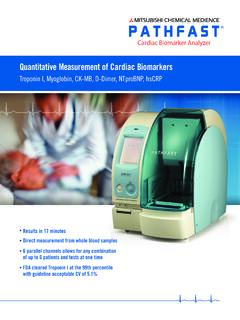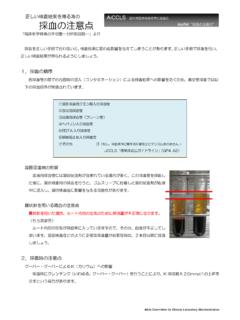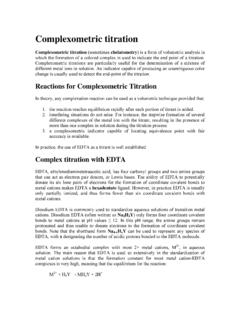Transcription of Excyte ESR Tubes - vitaldiagnosticsinc.com
1 Excyte ESR Tubes EX-50205 Vacuum Tubes , EX-50100 Non-Vacuum Tubes Instructions for use for in vitro diagnostic instruments for professional use. Intended Use Excyte ESR Tubes are for the quantitative determination of the erythrocyte sedimentation rate (ESR) of whole blood using the following Excyte ESR analyzers as mentioned in section Materials required but not provided. Summary and Principle of Method It is well established that patients affected by various diseases ( tuberculosis, malignancies, rheumatic fever, rheumatoid arthritis, multiple myeloma and acute inflammation) have a raised ESR1-6, due mainly to alterations in some plasma and erythrocyte factors causing the formation of erythrocyte rouleaux 7-9. The Excyte ESR system is comprised of a whole blood collection tube and an Excyte ESR analyzer.
2 The analyzers (listed under Materials required but not provided) are automated instruments, controlled by a microprocessor and exclusively employed for the analysis of ESR. The analyzers can be used for random and continuous loading of samples while following the sedimentation of each sample independently. Whole blood is collected in the 120mm Excyte ESR tube containing mL of sodium citrate. One tube is required for each determination. The Excyte ESR tube, containing whole blood and mixed well (refer to Procedure section of these instructions for use), is placed in an individual channel in the Excyte ESR instrument. Once the presence of a tube is detected by the instrument, a photoelectric cell passes up the outside of each tube to record the height of the column of red cells at which light transmission occurs at 950 nm (infrared).
3 After 30 minutes of sedimentation, the new level at which light passes through the column is recorded and the decrease in height is corrected mathematically to give a result which is comparable to a 1 hour Westergren ESR. Reagents Composition EX-50205: 50 vacuum Tubes per box. Irradiated 8x120mm glass Tubes with a butyl-rubber stopper. The tube contains , sodium citrate and is ready for use. EX-50100: 50 non-vacuum Tubes per box. Irradiated 8x120mm glass Tubes with a butyl-rubber stopper. The tube contains , sodium citrate and is ready for use. Warnings And Precautions For in vitro diagnostic use. Handle and dispose of all human source materials as though capable of transmitting infectious agents using the universal precautions recommended by the Centers for Disease Control and Prevention (CDC)10.
4 Do not pipette by mouth; do not eat, drink, smoke or apply cosmetics in areas where specimens are handled. Clean up spills immediately with a sodium hypochlorite solution. Insert the tube gently into the analyzer to prevent breakage. If the stopper is removed after collection and reinserted, the seal will be weakened and the stopper could separate from the tube, which could result in a spill inside the analyzer, causing damage and contamination. Reagent Preparation The Excyte ESR Tubes are supplied ready to use. For single use only. Reagent Storage And Stability Store the Excyte ESR Tubes 4 to 25 C. When stored correctly, Tubes can be used up to the expiration date printed on the label. Specimen Collection For vacuum Tubes (EX-50205) 1.
5 Apply the tourniquet. 2. Disinfect the venipuncture site. 3. Apply a sterile needle to the draw vacuum device. 4. Perform venipuncture with patient s arm in a downward position and the tube in an upward position11. 5. Do not remove stopper to add anything to the sample. 6. To avoid coagulation, mix the blood immediately with the sodium citrate solution by turning upside down several times. Note: If blood collection utilizes a butterfly system, the Excyte ESR tube must not be the first tube in the collection order. The dead volume of the butterfly device must be filled with blood prior to collection using the Excyte ESR tube. For non-vacuum Tubes (EX-50100) 1. Collect the whole blood specimen in an EDTA tube according to accepted clinical protocol11.
6 2. Mix blood well prior to transferring to the Excyte ESR tube. Specimen Storage and Stability In accordance with the recommendations of the International Committee for the standardization in Hematology (ICSH), blood samples collected in this manner and stored in an Excyte tube should be tested within 4 hours if left at room temperature (18 to 25 C)12. Within the 4 hours it is possible to analyze the same sample twice, after a mixing step of at least 10 minutes. The specimen may be kept refrigerated (2 to 8 C) for up to 12 hours, but must be brought to room temperature and mixed thoroughly prior to analysis. Blood used for ESR testing and stored in an EDTA tube is stable for up to 24 hours if refrigerated13, but must be brought to room temperature and mixed thoroughly prior to analysis.
7 Procedure Materials Provided Excyte ESR Tubes , Product Numbers: EX-50205 or EX-50100 Materials required but not provided 1. Analyzer: Product Product Number (North America) Sample Positions Excyte 10 EX-10312 10 Excyte Mini EX-10310 10 Excyte M EX-10314 10 Excyte 20 EX-10318 20 Excyte 40 EX-10316 40 2. Accu-Sed Plus ESR Controls: Product Product Number (North America) Configuration Normal DS-71002 5 x mL Abnormal DS-71003 5 x mL Combined DS-71005A 5 x mL (Normal) Installation and Use Before performing the ESR determination, carefully read the instructions contained in the instrument manual. After blood is drawn and the Excyte ESR Tube is filled with 1 mL of blood, mix the sample immediately with the sodium citrate.
8 Immediately prior to analysis, the sample should be mixed thoroughly as described below. 1. Program the instrument according to the instructions in the Operator s / User Manual14-18. 2. Draw the blood as directed under Specimen Collection . 3. Tube should be filled to at least the minimum line and not more than the maximum line on the tube. If too little sample is present (below the minimum mark SAMPLE LOW) the sample will be rejected by the instrument without being analyzed. 4. Mix the blood with the sodium citrate solution by turning upside down at least 10 times, before placing the tube in the instrument, or use an automatic rotating mixer DuoMix) with a RPM value of 15 20.
9 5. Insert (gently to avoid breakage) the tube containing a well-mixed patient sample into any open channel and record the position number. 6. At the end of the cycle, the result is shown on the display, according to the order of the numbered positions. If an optional Excyte printer is included, the result will be printed at the end of 30 minutes. 7. Once the measurement is complete and the value has been recorded or printed, remove the tube. 8. Instrument is now ready to perform a new cycle. 3. Duo-Mix (optional): Product Number (North America) Configuration EX-10573 40 pos. for 8-10mm Tubes EX-10577 40 pos. for 13mm Tubes EX-10578 20 pos. for 8-10mm Tubes & 20 pos. for 13mm Tubes 4. Excyte Printer, Optional, Product Numbers: EX-13886 (North America) 5.
10 Excyte Barcode Scanner, Optional, Product Numbers: EX-10551 (North America) Calibration Calibration is not required. Quality Control ELITechGroup recommends running two levels of controls (normal and abnormal) each day of use. The recommended controls are the Accu-Sed Plus ESR controls. Refer to the Accu-Sed Plus package insert19 for further instructions, including expected values. Refer to the instrument operator s / user s manual for specific quality control instructions. Calculations All calculations are performed by the instrument. Limitations Interfering Substances The following external factors can alter the ESR value after blood collection and should be avoided: improper dilution ratio, bubbles, foam, grossly hemolyzed samples, sudden agitation, temperature outside recommended operating conditions of 15 to 32 C, direct sunlight, and lipemic samples.








